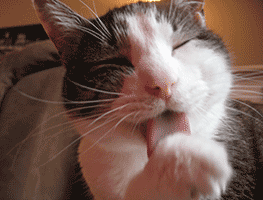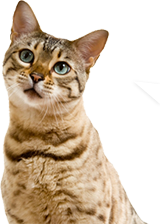Cat Enrichment
Providing both mental and physical enrichment/exercise is important to help your cat live a happy, healthy, stimulating life,. When cats live outside, they hunt, climb, and explore. These are wonderful forms of exercise and enrichment, but outdoor life poses many dangers for a cat, so we recommend you keep your cat indoors. Our houses don’t naturally provide the same level of enrichment, so it is our job as cat guardians to create sources of both mental and physical exercise.

Treat dispensing toys
One excellent way to encourage your cat to “hunt” or “forage” when living inside is to give them a treat/puzzle toy. However, most stores offer far fewer puzzle options for cats than for dogs, so making your own using everyday items is highly recommended (and saves money). Here are a couple ideas you can create at home:
Use an old cardboard box (remove any plastic or labels) and cut small holes, wide enough for a paw to reach in. Place several treats or pieces of kibble inside and seal the box. The cat will have to reach inside or knock the box around to get out the pieces of food. You can do the same thing using empty paper towel tubes by folding the ends up and cutting holes along the length of the tube, or you could try using an empty cardboard egg carton. You can even use paper bags – just place several treats, crumbled paper, and toys inside, then allow your cat to pull the paper out to get the treats and/or toys.
Mealtime is a great opportunity to provide your cat with hunting and foraging practice! Take their kibble and divide it into several empty toilet paper tubes, then place the tubes around a single room of your home. When you first introduce your cat to this game, make the tubes easy to find by keeping them highly visible and relatively close together. Your cat will have to use their nose to smell and search for the food. Once your cat learns the game, you can begin to make the tubes incrementally harder to find, resulting in your cat having to hunt around the room for their meal. If your cat is the only animal in the home, you can expand the hunt to multiple rooms. If you have other animals in the home, be sure to block off access to the “foraging” room during the hunt. If you have multiple cats, you can close the cats in separate rooms allowing them to have their own individual meal hunt.
Interactive toys
Cat are active, energetic animals and in addition to providing stimulation for their minds, we also need to provide outlets for their physical energy. Schedule 2-3 play sessions for you and your cat each day. This will consist of taking 5 to 10 minutes (or longer if your cat stays engaged and would benefit from more activity) multiple times a day, engaging your cat in active play. Using a wand-type toy during these play sessions is recommended, as the movement encourages your cat to run and jump for the toy while keeping your hands safely out of the cat’s reach.
Solo Toys
It is also important to supply your cat with a variety of toys they can engage with on their own throughout the day. This could include crinkle balls, fake mice, catnip toys, etc. Visit the Wisconsin Humane Society’s store or shop online to purchase the toys of your choice. To keep your cat engaged and the toys novel, rotate your toys every few days, having just 3 or 4 toys out at a time and storing the rest. This will keep their toys exciting and new without you having to frequently purchase new ones!
Scratching Posts
Scratching is another natural behavior for cats. By providing appropriate items for your cat to scratch on, you are not only reducing the likelihood your cat will scratch an unwanted surface, but also provide enrichment and a healthy way for them to practice a natural behavior. See the Cat Scratching handout for more information on scratching posts.
Create vertical spaces and hiding spots
Cats love to have a view and this means having multiple levels to climb. You can purchase a cat climber or get creative using DIY options like book shelves, dresser drawers, and other household items. Just be sure they are strongly secured and won’t tip or fall under the cat’s weight. If you have a skittish cat, it’s important to provide them with contained space in every living area where they can go to feel safe. Whether it’s space under your bed, a cozy blanket under a side table, or a store-bought hidey box, your cat will be grateful for the chance to unwind.
Music and videos
Just like humans, cats enjoy the sights and sounds of nature. If you can place a climber or piece of furniture near a window, they’ll admire the passing critters before eventually drifting off to sleep. During warmer weather, you can open the windows as long as you have secure screens in place. When it’s too cold out for open windows, try playing a nature soundtrack or animal show on your television. If you search online, there are many YouTube videos created for cats that show squirrels, birds, or aquariums. These should be provided for short periods of enrichment, not left on all day.
Field trips outside
Although it is important for a cat’s health and safety to live indoors, supervised field trips or other forms of outdoor experiences can be great enrichment and beneficial to your cat’s life. Here are a couple ways you can safely provide your cat time outside.
Leash walking
Like dogs, you can take your cat for a walk on a leash! This adventure will most likely result in less walking and more exploring around a small space, so while it won’t provide you much exercise, it will provide your cat a great deal of enrichment. When deciding to take your cat outside on leash, there are a few things to consider. First, it is important to acclimate your cat to a harness and leash inside before venturing outside. Many cats are initially uncomfortable with a harness and leash. It is important to slowly introduce them to this equipment. See the handout on Leash Training for details on how to begin this process.
Once your cat is comfortable on leash, consider where you are going to explore. Ideally, you will stay close to home and provide your cat a grassy area with trees, bushes, flowers, etc. Make sure all your nearby plants are safe for cats before allowing them to explore, and keep your cat far away from traffic. If you have loose dogs in your area, make sure you are in a fenced-in space to avoid an accidental encounter with an unknown dog.
Outdoor cat enclosures
You can also create an outdoor enclosure for your cat. This could be anything from a window box attached to your home, to something larger resembling a chicken coop. The important part is making sure your cat cannot escape and unintended animals can’t get in. When your cat is in their enclosure, be sure to monitor them at all times. Check out Catio Space online for ideas on how to create your own DIY cat enclosure.
Cat strollers
Cat strollers are not for every cat, as some will find it scary and stressful. However, for some cats who are confident and want to explore, strolling along with the family can be a very positive experience. To see if your cat would enjoy a stroller ride, begin with the stroller inside and allow your cat to explore the novel object. Place treats in the stroller seat to encourage them to jump in and test it out. If they are comfortable, begin with an indoor ride and watch your cat’s body language. If they are yowling, trying to dart away, or cowering in the stroller, they either need more time to get used to the stroller slowly indoors, or they may not be the stroller type. If your cat is relaxed, looking around, and not showing signs of stress, then take the next step of going outside. Keep your walks brief and close to home at first, slowly working up to longer trips as your cat acclimates over time. Continue to observe your cat’s body language throughout every walk outside. Enrichment is meant to stimulate your cat’s mind, not increase stress.
If your living situation does not allow for you to take your cat on outdoor adventures, consider bringing the outdoors inside for your cat’s enjoyment.
Nature enrichment boxes
Create a nature box for your cat to explore. Take a cardboard box or a low sided Rubbermaid container, and place objects from nature inside. This could include sticks, leaves, grass, cat-safe flowers or tree clippings, rocks, etc. Place this box on the floor inside your house and allow your cat to explore and investigate. This will provide new textures and smells to stimulate your cat’s mind.
Cat grass
Cat grass is specific grass (generally rye, wheat, or barley) grown inside for your cat’s enjoyment and enrichment. Cats are naturally drawn to the grass and many enjoy chewing on it. There are several health benefits to cats eating cat grass, as well. Cat grass is high in fiber and helps with hairballs.
Window views
Providing a way for your cat to comfortably sit by the window and observe the outside world can be enriching for a cat. To up the fun, you can open a screened window during nice weather and allow your cat to experience the fresh air and smell the scents from outside. You can also place a bird feeder outside the window to attract birds and provide a live “TV show” for your cat to enjoy.

